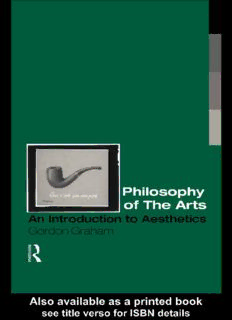
Philosophy of the Arts: An Introduction to Aesthetics PDF
Preview Philosophy of the Arts: An Introduction to Aesthetics
PHILOSOPHY OF THE ARTS Philosophy of the Arts is designed specifically for readers studying aesthetics for the first time; it is the first comprehensive introduction for students of philosophy, as it will be for those of literature, music, or art. Written in nontechnical language, equipped with regular summaries of the argument and suggestions for further reading, this textbook is up-to-date and full of examples from all the arts, from film to poetry, architecture to music. The chapters consider: (cid:1) The value of art: as a form of entertainment, a source of beauty, a means of emotional expression, or something bringing insight and understanding. (cid:1) The theories of Hume, Mill, Kant, Habermas and Collingwood. (cid:1) Central topics in the philosophy of music: musical expression, music as a language, the uniqueness of music. (cid:1) The importance of representation to painting; some central problems of film theory. (cid:1) Philosophical issues in the literary arts, for example, ‘What does poetry lose in paraphrase?’ and a wide-ranging discussion of literary devices. (cid:1) The context in the philosophy of architecture for the debates between formalists and functionalists, modernists and traditionalists. (cid:1) The Marxist, structuralist and modernist objections to philosophical aesthetics; with the writings of Althusser, Lukács, Lévi-Strauss and Derrida. (cid:1) A defence of normative theories of art in Hegel and Schopenhauer. Ideal for readers who do not necessarily have a background in philosophy and are new to aesthetics, Philosophy of the Arts is a clear, accessible introduction to what is often seen to be a difficult but fascinating subject. Gordon Graham is Regius Professor of Moral Philosophy at King’s College, University of Aberdeen. He has published widely on ethics, aesthetics, and social philosophy; his books include Contemporary Social Philosophy (1987), The Idea of Christian Charity (1990), Ethics and International Relations (1996), and The Shape of the Past (1997). PHILOSOPHY OF THE ARTS An Introduction to Aesthetics Gordon Graham London and New York First published 1997 by Routledge 11 New Fetter Lane, London EC4P 4EE Simultaneously published in the USA and Canada by Routledge 29 West 35th Street, New York, NY 10001 This edition published in the Taylor & Francis e-Library, 2001. © 1997 Gordon Graham All rights reserved. No part of this book may be reprinted or reproduced or utilised in any form or by any electronic, mechanical, or other means, now known or hereafter invented, including photocopying and recording, or in any information storage or retrieval system, without permission in writing from the publishers. British Library Cataloguing in Publication Data A catalogue record for this book is available from the British Library Library of Congress Cataloging in Publication Data A catalog record for this book is available from the Library of Congress ISBN 0–415–16687–X (hbk) ISBN 0–415–16688–8 (pbk) ISBN 0-203-00443-4 Master e-book ISBN ISBN 0-203-17462-3 (Glassbook Format) In memory of Christina Marie Kennedy (1974–1997) to whom these questions mattered Contents Acknowledgements xi Introduction 1 1 ART AND PLEASURE 4 Hume and the standard of taste 4 Mill and pleasure 5 Kant and beauty 11 Gadamer and art as play 15 Art and sport 18 Summary 21 2 ART AND EMOTION 24 Tolstoy and everyday expressivism 24 Collingwood’s expressivism 31 Expression versus expressiveness 33 Summary 40 3 ART AND UNDERSTANDING 42 Art and knowledge 43 Aesthetic cognitivism 46 Art as understanding 47 Imagination and experience 50 The objects of imagination 53 Art and the world 56 Understanding as a norm 59 Art and human nature 60 Summary 62 4 MUSIC AND MEANING 64 Music and pleasure 65 Music and emotion 68 Music as language 71 vii CONTENTS Music and representation 74 Musical vocabulary and musical grammar 76 Resumé 79 The uniqueness of music 80 Music and beauty 81 Music as the exploration of sound 83 Summary 85 5 FROM PAINTING TO FILM 87 What is representation? 88 Representation and artistic value 89 Art and the visual 92 Visual art and the non-visual 96 Film as art 100 Montage versus long shot 101 ‘Talkies’ 104 The ‘auteur’ in film 106 Summary 108 6 POETRY AND PARAPHRASE 110 Poetry and prose 110 The unity of form and content 113 Figures of speech 114 Expressive language 116 Poetic devices 118 Narrative and fiction 123 Literature and understanding 127 Summary 129 7 ARCHITECTURE AS AN ART 131 The peculiarities of architecture 131 Form and function 135 Façade, deception, and the ‘Zeitgeist’ 137 Functionalism 140 Formalism and ‘space’ 141 Architectural expression 144 Architecture and understanding 145 Summary 147 8 THEORIES OF ART 149 Defining art 149 Art as an institution 156 Marxism and the sociology of art 158 Lévi-Strauss and structuralism 163 viii CONTENTS Derrida and deconstruction 166 Normative theory of art 171 Summary 175 EXAMPLES 178 Architecture 178 Film and television 179 Literature 179 Music 180 Paintings and sculpture 181 Bibliography 182 Index 185 ix
Description: